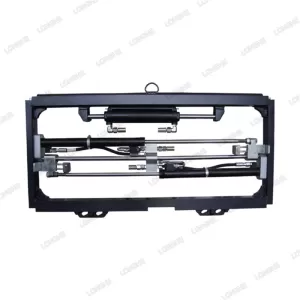Choosing the Right Fork Positioner for Your Warehouse: A Comprehensive Guide
Fork positioners are valuable attachments for forklifts that enhance material handling capabilities in warehouses and industrial settings. They allow for efficient and precise adjustment of the forks' width, enabling the handling of various load sizes. This comprehensive guide aims to assist you in selecting the right fork positioner for your warehouse by providing essential information and considerations.

Understanding Fork Positioners:
Fork positioners are hydraulic or mechanical attachments that enable the movement of forklift forks both laterally and longitudinally. They eliminate the need for manual adjustment, allowing operators to quickly adapt the forks to accommodate different pallet or load sizes.
Assessing Your Warehouse Needs:
Before choosing a fork positioner, it is essential to assess your warehouse requirements. Consider factors such as the types of loads you handle, load size variations, and the frequency of load changes. This evaluation will help determine the specific features and capabilities your fork pos iterator should possess.
Load Capacity and Fork Adjustment Range:
Ensure that the stone fork positioner you choose has a load capacity that matches your requirements. Additionally, consider the range of fork adjustment. The positioner should be capable of accommodating both smaller and larger load sizes to optimize versatility and efficiency in your warehouse operator ations.
Hydraulic or Mechanical Operation:
Fork positioners can be hydraulic or mechanical. Hydraulic positioners offer smooth and precise adjustments through hydraulic cylinders. Mechanical positioners use mechanical mechanisms like gears to achieve fork adjustment. Consider the pros and cons of each type and choose the one that best aligns with your operational needs and budget.
Mounting and Compatibility:
Verify that the chosen fork positioner is compatible with your forklift model. It should have the appropriate mounting options and fit seamlessly with your equipment. Consult the manufacturer's guidelines or seek expert advice to ensure compatibility and avoid any potential issues .
Control Options:
Consider the control options available for operating the fork positioner. Some positioners offer manual control through levers, while others have electronic controls integrated with the forklift's hydraulic system. Evaluate your preference, operator convenience, and the level of precision re required for your operations.
Durability and Maintenance:
Choose a fork positioner constructed with durable materials and components to withstand the demanding warehouse environment. It should be designed for longevity and require minimal maintenance. Optic for a reliable and robust model will reduce downtime and maximize productivity.
Safety Features:
Prioritize safety when selecting a fork positioner. Look for features such as automatic locking mechanisms to secure the forks during transport, load backrests for load stability, and guards to prevent damage to the positioner. Safety should be a paramount consideration to ens ure the well-being of operators and protect your warehouse assets.
Manufacturer's Reputation and Support:
Research the reputation and track record of the manufacturer or brand you are considering. Look for reliable and reputable manufacturers known for producing high-quality fork positioners. Additionally, assess the availability of customer support, spare parts, and after-sales services to en ure ongoing assistance if needed.
Cost and Return on Investment:
Evaluate the cost of the fork positioner against its features, capabilities, and expected return on investment. Consider factors such as increased productivity, reduced labor costs, and improved load handling efficiency. A slightly higher initial investment may prove worthwhi le if it delivers long-term benefits and meets your operational goals.
By considering these factors, you can make an informed decision when choosing the right fork positioner for your warehouse. Prioritize functionality, compatibility, safety, and long-term value to optimize your material handling processes and drive efficiency in your operations.
215
0
0
All Comments (0)
If you are interested in sending in a Guest Blogger Submission,welcome to write for us!




Comments